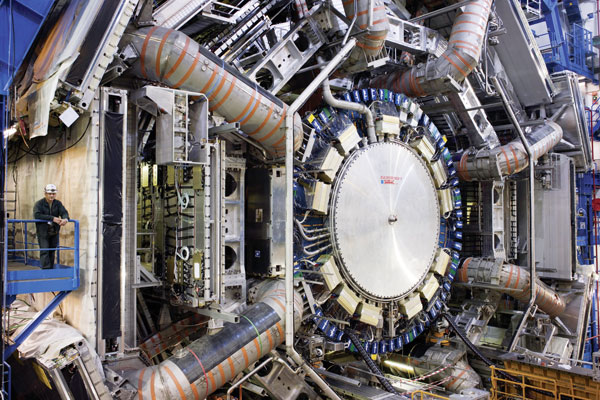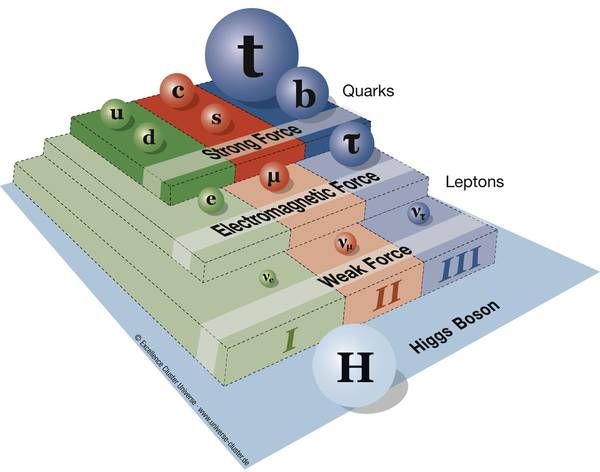Universe Scientists Provide Evidence of Higgs Particle
03.07.2012 —
Two international research teams from the ATLAS and CMS particle physics experiments presented their latest findings on the search for the Higgs particle at the European Organization for Nuclear Research in Geneva today. Both experiments, which are located at the world’s biggest particle accelerator, the Large Hadron Collider (LHC), observed a hitherto unknown particle in their detection devices that has a mass in the range of 125 to 126 gigaelectronvolts. It is very possible that this is the Higgs particle - the object of a decades-long search by physicists. This “ghost particle” is an essential component of the explanation as to how elementary particles get their mass. Numerous scientists from the Excellence Cluster Universe are involved in the ATLAS Experiment.
Highest energy protons circle the 27-kilometer-long LHC and are made to collide in large detection devices. During these collisions, particles can be generated like those which existed shortly after the Big Bang. However, they disintegrate very quickly and can be detected in the giant detectors on the basis of their disintegration products. Scientists have examined billions of such collisions in their search for the Higgs particle. Traces of the new 125-126 GeV particle have only been found in a few detector images.
In recent decades, the physicists developed a theory known as the Standard Model, which provides an excellent description of the building blocks of matter and the forces at work between them. However, this model has one weak point: all of the exchange particles that convey the forces would have to be massless. Yet, experiments clearly show that this does not apply to them all. To overcome this contradiction, Peter Higgs and other physicists introduced a new field in 1964. This Higgs field penetrates the entire universe and is intended to give the particles their mass. If this field exists, there should be a still undiscovered particle now referred to as the “Higgs particle”. An intensive search for this particle has been underway since then.
The precise measurement of the frequency with which the observed particle disintegrates in the individual channels will provide a key indication as to whether it is the long-sought Higgs particle. Deviations from the expected disintegration characteristics could indicate that other particles of this kind must exist or that the observed particle is something completely different. Finding this out will be the scientists’ next task during the coming months, if not years.
Physicists from Munich are also intensively involved in the search for the Higgs particle. Among the members of the international ATLAS collaboration are research groups from the Max Planck Institute for Physics (MPP), headed by Professor Siegfried Bethke, and from the Ludwig-Maximilians-Universität (LMU), headed by Professor Dorothee Schaile. Both scientists are also members of the Excellence Cluster Universe and receive significant support from this cluster of excellence. Together, both research groups are making important contributions to the Higgs quest, among other things through the fulfillment of coordination tasks within the international working group. In addition, the Munich scientists ensure that the detector components - the development of which they were involved in, including, for example, the inner track detector, the calorimeter, and the Myon spectrometer - measure the behavior of the elementary particles in the ATLAS detector accurately. Measurement data from the ATLAS experiment are also collected and analyzed on a daily basis at the Munich-based GRID computing center, which has also received significant financial support from the Excellence Cluster Universe.
Since the LHC commenced operation, the analysis of the measurement data has been a key focus of attention for the physicists in Munich. “It is very exciting that after such a long period of planning and preparation, success is now being achieved,” comments Dorothee Schaile on the CERN results. Research groups involved with Higgs physics at both the LMU and the MPP evaluate current measurement data from the ATLAS experiment. “We discovered a new particle that had never been seen before. And although its properties are not yet known in detail, its mass, production frequency, and disintegration signatures are. Therefore, it is very likely that this particle is a boson, probably the Higgs boson from the standard model. But it could also be something much more exciting! In the years to come, we will be measuring its exact characteristics in greater detail and will then be able to say exactly what it is,” explains Siegfried Bethke.
Picture gallery and download







